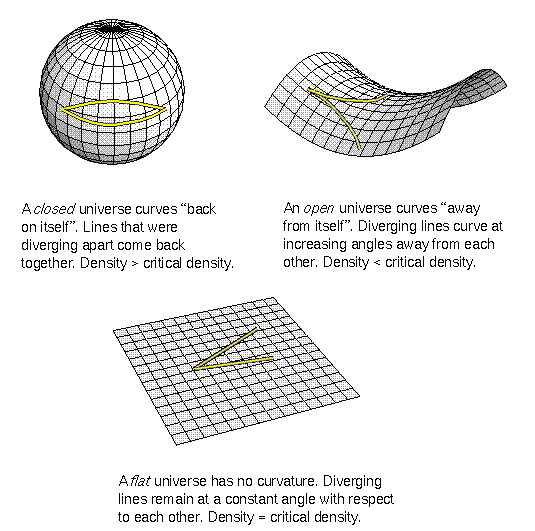
This material (including images) is copyrighted!. See my copyright notice for fair use practices.
Now that you have explored the beginnings of the universe and have an answer to the question ``where did we come from?'', let's address the other question, ``where are we going?'' This final section will cover the fate of the universe. We observe that the universe is expanding and that gravity is slowing it down. Which of them will win?

Instead of trying to add up all of the mass in the universe, a more
reasonable thing to do is to find the density of a representative
region of the universe. The density = (mass in the region)/(volume of the
region). If the region is truly representative, then the total mass of the
universe = the density × the total volume of the universe.
If the density is great enough, then the universe is closed. If the density is
low enough, then the universe is open. In the popular astronomy magazines,
you will probably see the
mass density of the universe specified by the symbol ``![]() ''.
It is the ratio of the current density to the ``critical density'' described in the
next paragraph. If
''.
It is the ratio of the current density to the ``critical density'' described in the
next paragraph. If
![]() < 1, the universe is open; if
< 1, the universe is open; if ![]() > 1, the universe is closed.
> 1, the universe is closed.

A critical density universe has ``flat'' curvature. The ![]() density parameter equals exactly 1 in a flat universe. The Hubble
``constant'' is not really a constant—it is different at different cosmological times.
The greater the value of the Hubble constant at a given cosmological time,
the faster the universe is expanding at that time.
Gravity slows the expansion of the universe, so the early universe was
expanding faster than it is now. That means that the critical density was
greater at earlier times. It changes by the same factor that the actual density
of the universe changes throughout the expansion. So if the universe starts out
with a density greater than the critical density, then its
density will always be greater than critical density. If the universe
starts out with a density less than the critical density, then its density will
always be less than the critical density.
density parameter equals exactly 1 in a flat universe. The Hubble
``constant'' is not really a constant—it is different at different cosmological times.
The greater the value of the Hubble constant at a given cosmological time,
the faster the universe is expanding at that time.
Gravity slows the expansion of the universe, so the early universe was
expanding faster than it is now. That means that the critical density was
greater at earlier times. It changes by the same factor that the actual density
of the universe changes throughout the expansion. So if the universe starts out
with a density greater than the critical density, then its
density will always be greater than critical density. If the universe
starts out with a density less than the critical density, then its density will
always be less than the critical density.
![]() Go back to previous section --
Go back to previous section --
![]() Go to next section
Go to next section
last updated: June 28, 2022